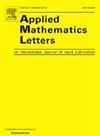双峰斯托克斯波
IF 2.9
2区 数学
Q1 MATHEMATICS, APPLIED
引用次数: 0
摘要
研究了无限深度理想流体表面上的双峰行斯托克斯波。继陈&;Saffman(1980),我们把这些波称为II类Stokes波。II类波是由斯托克斯波的初级分支在远离平面的地方分叉形成的。这些波是强烈非线性的,并且与小振幅解分离。在速度与陡度图的前两个振荡中发现了明显的II类分岔。不同振荡中的分岔不是通过连续的II类波连接起来的。我们遵循第二类波的前两个族,我们称之为次级分支(即第二类分支)和第三类分支(即第二类分支)。与Stokes波类似,II类波随着其陡度的增加,在速度上遵循一系列振荡,并且表明存在极限II类Stokes波,其特征是在每个其他波峰处呈120度角。本文章由计算机程序翻译,如有差异,请以英文原文为准。
Two-crested Stokes waves
We study two-crested traveling Stokes waves on the surface of an ideal fluid with infinite depth. Following Chen & Saffman (1980), we refer to these waves as class Stokes waves. The class waves are found from bifurcations from the primary branch of Stokes waves away from the flat surface. These waves are strongly nonlinear, and are disconnected from small-amplitude solutions. Distinct class bifurcations are found to occur in the first two oscillations of the velocity versus steepness diagram. The bifurcations in distinct oscillations are not connected via a continuous family of class waves. We follow the first two families of class waves, which we refer to as the secondary branch (that is primary class branch), and the tertiary branch (that is secondary class branch). Similar to Stokes waves, the class waves follow through a sequence of oscillations in velocity as their steepness rises, and indicate the existence of limiting class Stokes waves characterized by a 120 degree angle at every other wave crest.
求助全文
通过发布文献求助,成功后即可免费获取论文全文。
去求助
来源期刊

Applied Mathematics Letters
数学-应用数学
CiteScore
7.70
自引率
5.40%
发文量
347
审稿时长
10 days
期刊介绍:
The purpose of Applied Mathematics Letters is to provide a means of rapid publication for important but brief applied mathematical papers. The brief descriptions of any work involving a novel application or utilization of mathematics, or a development in the methodology of applied mathematics is a potential contribution for this journal. This journal''s focus is on applied mathematics topics based on differential equations and linear algebra. Priority will be given to submissions that are likely to appeal to a wide audience.
 求助内容:
求助内容: 应助结果提醒方式:
应助结果提醒方式:


